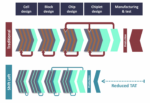Customer case studies have always been my favorite source of information. Press releases are a great start but there is always more to the story. Fortunately, I had the opportunity to speak with Sumit Vishwakarma, principal product manager at Siemens EDA about their recent press release with Interchip. I was an advisor to Berkeley… Read More
A Game-Changer for IP Designers: Design Stage Verification
In today’s rapidly evolving semiconductor industry, the design and integration of intellectual property (IP) play a pivotal role in achieving competitive advantage and market success. Whether sourced from commercial IP providers or developed in-house, ensuring that IP designs are compliant with signoff requirements… Read More
Soft checks are needed during Electrical Rule Checking of IC layouts
IC designs have physical verification applications like Layout Versus Schematic (LVS) at the transistor-level to ensure that layout and schematics are equivalent, in addition there’s an Electrical Rules Check (ERC) for connections to well regions called a soft check. The connections to all the devices needs to have the most… Read More
New Emulation, Enterprise Prototyping and FPGA-based Prototyping Launched
General purpose CPUs have run most EDA tools quite well for many years now, but if you really want to accelerate something like simulation then you start to look at using specializedhardware accelerators. . Emulators came onto the scene around 1986 and the processing power has greatly increased over the years, mostly in response… Read More
AI and SPICE Circuit Simulation Applications
Can you name the EDA vendor that first used AI starting 15 years ago for circuit designers using SPICE simulators? I can remember that vendor, it was Solido, now part of Siemens EDA, and I just read their 8 page paper on how they look at the various levels of AI being used in EDA to help IC designers work smarter and faster than using manual… Read More
Mastering Mixed-Signal Verification with Siemens Symphony Platform
Digital design and verification is well understood by EDA vendors and IC designers, however mixed-signal design and verification is more challenging, because the continuous nature of analog signals requires more compute resources and specialized design skills. Siemens EDA has a unique offering in what they call Symphony… Read More
Cryogenic Semiconductor Designs for Quantum Computing
Over the last few years, there has been an increase in news about quantum computing. Much of this news coverage has been around computing supremacy, potential threats to information security and quantum cryptography. While the field of quantum computing is still in its early stages, there are several companies who have already… Read More
Achieving a Unified Electrical/Mechanical PCB Design Flow – The Siemens Digital Industries Software View
Let’s face it, designs are getting harder, much harder. Gone are the days when the electrical and mechanical design of a system occurred separately. Maybe ten years ago this practice was acceptable. Once the electrical design was completed (either the chip or the board) the parameters associated with the design were then given… Read More
Making UVM faster through a new configuration system
The Universal Verification Methodology (UVM) is a popular way to help verify SystemVerilog designs, and it includes a configuration system that unfortunately has some speed and usage issues. Rich Edelman from Siemens EDA wrote a detailed 20-page paper on the topic of how to avoid these issues, and I’ve gone through it to… Read More
SPIE 2023 Buzz – Siemens Aims to Break Down Innovation Barriers by Extending Design Technology Co-Optimization
Preventing the propagation of systematic defects in today’s semiconductor design-to-fabrication process requires many validation, analysis and optimization steps. Tools involved in this process can include design rule checking (DRC), optical proximity correction (OPC) verification, mask writing and wafer printing… Read More











